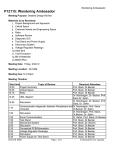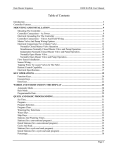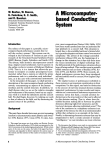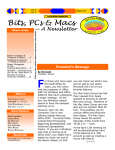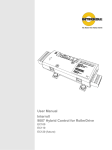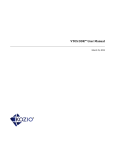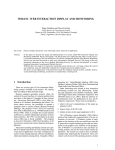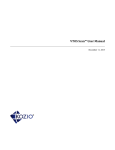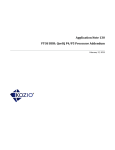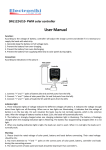Download Tune and test
Transcript
INSTRUMENTS Tune and test DDR MEMORY M odern electronic devices rely on stable DDR (double data rate) memory for fast, reliable operation. A shortened time to market, however, often limits the amount of product testing that you can perform. Microprocessor-based products released with unstable memory may experience only intermittent failures, but even those can lead to a costly recall. To minimize that risk, you can follow a comprehensive memory tuning and testing process that you can verify with an oscilloscope or logic analyzer. Tuning is part of configuring a computer system’s DDR memory. Device-specific tuning will match a DDR memory device’s timing parameters with the configuration registers in the DDR memory controller’s CPU. Data sheets for DDR devices specify the timing required for proper operation, listed as fractions of a second.You must convert these timing parameters to clock cycles before you can program them into a memory controller. For this conversion, you should write some high-level DDR memory configuration software that will accept the standard timing data from a data sheet and convert it into processor clocks for low-level DDR memory drivers. The next step of the tuning process will vary depending on your product’s CPU. Many CPUs let the user tune DDR DOUBLE DATA RATE MEMORY POSES A TRADEOFF BETWEEN PERFORMANCE AND STABILITY. memory parameters such as signal termination and read/write delays that may be specific to a particular board layout. The user manual for a DDR memory controller will specify any tuning capability that it provides. BY ANDREW FISH, KOZIO Read/write delays When included as part of the DDR memory controller, modified read delays or write delays can lead to the most stable system. A product may have several read/write delay values for which the DDR memory device will work—a window of operability. You should test those delay windows under a range of operating conditions, such as varying temperatures, to find the settings that will optimize DDR mem(continued) ory reliability. TEST & MEASUREMENT WORLD www.tmworld.com DEC. 2008/JAN. 2009 45 INSTRUMENTS Figure 1 depicts the timing of DDR memory write cycles with and without delays. You may need to add delays because the strobe and data transfer will shift in time relative to the DDR memory clock (not shown in Figure 1). In some cases, the read/write delay tuning and adjustment will occur every time a user powers on the product. Many designs, however, rely on this tuning process to occur during design only, with the released product using the optimal values that balance performance and reliability. After you complete the initial tuning, you should put the product through several levels of validation testing. In some cases, testing will reveal the need for additional tuning. The key to effective DDR memory testing is to make your tests progressively more difficult, covering connectivity, memory retention, stress, and performance. A best practice in DDR memory design is to manually verify that the PCB (printed-circuit board) traces are con- Write data strobe clock Data bus Write data clock delay tuning value Write data strobe clock with delay Write data clock delay tuning value Data bus with delay FIGURE 1. Adding delay to a write cycle can improve performance and system stability. the given address. First, the software sets the LSB (least-significant bit) to 1 and all other bits to 0. Next, the software sets the next LSB to 1 and all other bits to 0; and so on, until each bit has been set to 1 (Figure 2). After you verify connectivity, you should run functional validation tests to ensure that all the memory cells in the DDR memory can retain the values written to them. Filling and verifying all the cells with their own address values as data can accomplish this task. Additionally, you should fill all the cells and verify that all the memory cells MSB LSB can store both ones and ... 0 0 0 0 0 0 0 1 zeros. Use the one’s ... 0 0 0 0 0 0 1 0 complement of the cells’ ... addresses to run this test. 0 0 0 0 0 1 0 0 S eve r a l a d va n c e d .. CPUs include software . that perfor ms DDR ... 1 0 0 0 0 0 0 0 memor y stress tests, which ensure that the FIGURE 2. A walking-ones data pattern ensures that no memory can perform at shorts exist across data lines. your system’s full speed. nected.You can use an oscilloscope, logic Such processors can simulate an applicaanalyzer, or multimeter for this connec- tion-like environment. By running your tion test. Once you complete this initial functional tests with cache enabled, you design check, software tests can verify the will also force data bursts between the DDR memory address and data line con- processor and DDR memory as cache nections for proper operation at the speed lines get flushed and replaced. Running of the processor. An address bus test writes DMA (direct-memory access) loop tests a base pattern and then a test pattern to all while also receiving Ethernet packets via power-of-two offsets (0001h, 0002h, interrupts can cause multiple simultaneous 0004h, etc.). Data bus tests use a “walk- DDR memory reads and writes that will ing-ones-and-zeros” pattern that tests stress the memory and ensure coherency. across the width of the data bus on a sinFigure 3 illustrates the block-level ingle memory word. These tests verify that teraction of the DDR memory with a no shorts exist to power or ground or be- system’s cache memory, DMA, and Ethtween any data lines or any address lines. ernet controllers. Each line between the components represents data transfers Walking ones from one logic component to the other. For a walking-ones pattern, your soft- In the case of DMA, you can program ware, whether purchased or written in- multiple transfers to occur simultanehouse, must perform successive writes to ously across multiple channels. The ac46 DEC. 2008/JAN. 2009 tual number of channels is a feature of a particular microprocessor. Knowing that your DDR memory is properly connected and won’t produce errors under stress isn’t always enough. You must also measure how well the DDR memory performs. Using a software test with optimized read and write routines, you can determine whether the performance and throughput of the DDR memory are fast enough to ensure that software running in your system will run properly.You must measure performance early in a product’s development to resolve any bottlenecks in the data path. Dedicated applications When developing software for tuning and testing DDR memory, you should implement the needed routines in a dedicated software application. Although you could develop JTAG tests for tuning and testing—a fairly simple process—you wouldn’t be able to operate the DDR memory at a processor’s full speed, which is a major testing limitation. Building DDR memory tests on top of an application is also a tempting option, but this approach for memory testing makes it difficult to find a problem’s root cause because of the many layers of software that test routines use. You should develop modular DDR memory test software (Figure 4) so you can reuse test routines across departments throughout your organization. Design engineers can use the software for initial DMA Cache DDR Ethernet FIGURE 3. During a test, DDR memory must interact with cache memory, DMA, and Ethernet controllers. www.tmworld.com TEST & MEASUREMENT WORLD Start Because the same software was used to validate the product’s design, there will be no need to rerun extensive stress or perProgram controller formance tests during manufacturing. with transfer Modular software will also let you run parameters of chain the same routines in a POST (power-on m on channel n self-test) application. If POST is required, it often needs to run quickly but have More the ability to warn end users if a memory Yes transfers problem exists. Thus, you can use DDR in chain? memory test routines to uncover potential memory problems before they affect No a system’s operation. You can also use DDR memory test More Yes software on units that have failed in the channels field and have been returned for service. to program? Memory-testing software can quickly pinpoint the root cause of the problem. No Software that effectively validates a design initially should always be sufficient Initialize transfer ranges to deter mine problems on returned and start products. Field application engineers can all channels use the same set of software tests to validate memory during customer visits and find potential problems before the cusCheck tomer knows that a problem exists. error Stable DDR memory can often be conditions the key to a company’s success. Using a design process that includes proper tuning of DDR memory, followed by thorAll No channels ough memory validation testing will, at complete? least, assure you that you have a stable main platform. Additionally, if you create a DDR Yes memory tuning and testing process using a modYes Detected ular software approach, Fail error? you can reuse the process DMA_INTERRUPT_ERROR throughout your organiDMA_TIMEOUT_ERROR zation. Not only will the No DMA_VERIFY_ERROR reuse save money, it will Pass help your company to build reliable products and correct memory faults—whether found during deFIGURE 4. Modular test software lets engineers share test routines across velopment, in production, or in the field. departments. Stable memory can’t guarantee that your product will be a success, but neglecting board verification. Test engineers can use to spend time ensuring that your prodthe test routines to determine if a prob- uct has stable memory will nearly always lem is related to hardware or software by lead to failure. T&MW using known-good tests. A known-good test contains no programming errors that Andrew Fish is a senior contributor to would produce false results, such as iden- Kozio’s library-based functional tests. He tifying errors that don’t exist or missing joined Kozio in 2004 and has more than 11 years of embedded programming experierrors that do exist. ence. Fish has developed advanced test Test engineers and manufacturing en- capabilities and support for numerous migineers can also use the test routines to croprocessors and peripheral technologies. verify data paths and general functionality. He holds a BSEE from Marquette University. TEST & MEASUREMENT WORLD www.tmworld.com DEC. 2008/JAN. 2009 47



